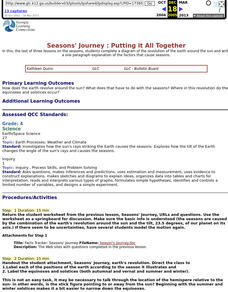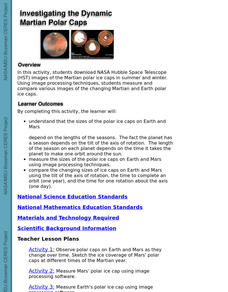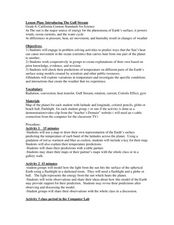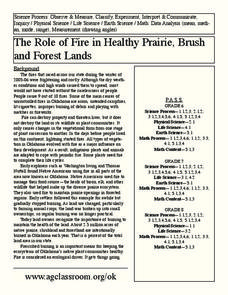CK-12 Foundation
Satellites, Shuttles, and Space Stations: Satellites in Orbit
Blast off! How do satellites, space shuttles, and space stations escape Earth's gravity and achieve orbit? Young astronauts study rocket science (literally) with an interactive lesson. They discover the four main uses for satellites, how...
Cornell University
Bacteria Take Over and Down
Bacteria outnumber all other forms of life on Earth. Scholars observe the growth of bacteria in petri dishes to understand their role in maintaining good health. Then, they observe the growth of bacteria after they introduce...
Curated OER
The Reason for the Seasons; Science, Geography
Learners think about what causes the seasons to change, reflect on what they know about seasons and how their lives affected by seasonal changes.
Curated OER
Geography: World Dynamics
Students discuss and examine how the world is changing. After reading an article, they discover the immediate changes that have taken place and how they have effected living things. They complete a worksheet identifying the changes as...
Curated OER
Global Warming – More or Less
Eighth graders identify the factors that contribute to global warming. In this earth science instructional activity, 8th graders evaluate the impact of global warming on the planet. They discuss their views within the group.
Curated OER
It's About Time
Students create their own timeline. In this social science instructional activity, students write the important events that happened in their lives on their timeline and then compare their timeline to Earth's timeline.
Curated OER
The Origins of Business
Students explore the world of inventions by utilizing Google Earth. In this global geography lesson plan, students research inventions such as the ball point pen, computer, telephone and typewriter. Students use the Google Earth software...
Curated OER
Climate in the Western Regions
Students examine the interactions of the Earth's systems and other objects in space. In this climate change lesson students study the pros and cons of different climates and what their preferences are.
Curated OER
Seasons' Journey : Putting it All Together
Third graders complete a diagram of the revolution of the earth around the sun and write a one paragraph explanation of the factors that cause seasons.
Curated OER
The Geologic Time Scale
Students research and explore the earth's past and make comparisons with the earth's present. They map out a timeline that explains how the earth and its organisms have changed over time. Studnets create a scale for their time line, they...
Curated OER
Biomes: Extreme Climate
Middle schoolers discuss the causes of global warming. In this earth science lesson plan, students examine how global warming is connected to the arctic and world climate. They write a paragraph about their interconnection.
Curated OER
Cool It! Comprehension
In this reading comprehension worksheet, students read a chart about the future of climate change and then complete the two worksheets that test their understanding of the text with a quiz and a graphic organizer about the changes that...
Curated OER
Investigating the Dynamic Martian Polar Caps
Students download NASA Hubble Space Telescope images of the Martian polar ice caps in summer and winter, and measure and compare various images of the changing Martian and Earth polar ice caps.
Curated OER
Seasons of the Year
Learners explore season change. In this season change lesson plan ,students investigate weather events, Earth's movement and celestial events. Learners watch videos and list weather events that happen in winter, spring, summer, and fall....
Curated OER
Introducing The Gulf Stream
Sixth graders research the average temperatures of different places on Earth. In this earth science lesson, 6th graders explain how the sun's heat cause ocean movement. They discuss how temperature change affects the weather we experience.
Curated OER
What's Your Favorite Season?
Students explore earth science by creating illustrations in class. In this four seasons activity, students identify the four different types of weather that take place during the year and read the books Harvest Year and Snow Comes to the...
Curated OER
Global Warming
Learners examine how human produced emissions of carbon dioxide contribute to global warming. Using the internet, they research the future effects of global warming on the Earth. In groups, they discover ways to reduce daily energy...
Curated OER
Germs: Cultural Diffusion
Students analyze agents of cultural diffusion. They discuss how the introduction of television would change various remote cultures, and in small groups create and present a skit demonstrating an agent of change.
Curated OER
Weather: Like It or Not!
Second graders investigate daily weather changes. In this earth science instructional activity, 2nd graders identify the different terms used to describe weather. They use the outdoor thermometer to record data.
Curated OER
Making Clouds: Aerosol-Cloud Interactions in a Beaker
Students observe a teacher demo on how clouds form. In this earth science lesson, students discover how cloudiness affects relative humidity. They explain the scattering of light by clouds.
Curated OER
Objects in the Sky
Students explore what the sky looks like at different times. They identify objects in the sky and recognize changes over time. Students observe the sky and look for objects that are common in both the daytime and the nighttime sky.
Curated OER
The Role of Fire in Healthy Prairie, Brush and Forest Lands
Students create a Venn diagram to compare and contrast wildfires and prescribed fires. In this earth science lesson plan, students conduct a series of experiment to explore fire characteristics. They describe favorable conditions to...
Curated OER
Beginning At Home
Students participate in activities that increase awareness of environmental stewardship. In this stewardship lesson, students discuss solutions to environmental problems and apply the solutions to ways they can keep their classroom...
Curated OER
How Many Days Are in a Year?
Young scholars create a calendar for an imaginary planet. In this earth science lesson, students analyze the errors on the different calendars used on Earth. They present their work in class.























